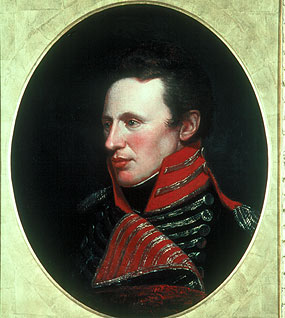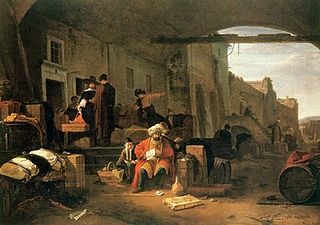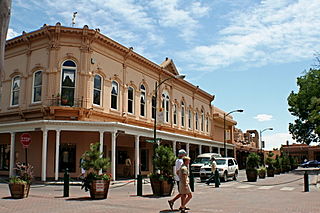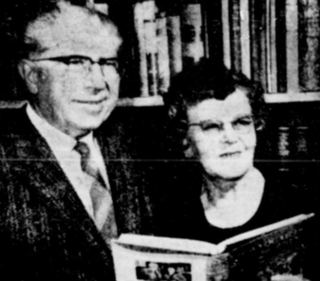
Santa Fe de Nuevo México was a province of the Viceroyalty of New Spain, and later a territory of independent Mexico. The first capital was San Juan de los Caballeros from 1598 until 1610, and from 1610 onward the capital was La Villa Real de la Santa Fe de San Francisco de Asís. The naming, capital, the Palace of the Governors, and rule of law were retained as the New Mexico Territory, and the subsequent U.S. State of New Mexico, became a part of the United States. The New Mexican citizenry, primarily consisting of Hispano, Pueblo, Navajo, Apache, and Comanche peoples, became citizens of the United States as a result of the Treaty of Guadalupe Hidalgo.

Zebulon Montgomery Pike was an American brigadier general and explorer for whom Pikes Peak in Colorado was renamed. As a U.S. Army officer he led two expeditions under authority of third President Thomas Jefferson through the new Louisiana Purchase territory, first in 1805-06 to reconnoiter the upper northern reaches of the Mississippi River, and then in 1806-07 to explore the Southwest to the fringes of the northern Spanish-colonial settlements of New Mexico and Texas. Pike's expeditions coincided with other Jeffersonian expeditions, including the Lewis and Clark Expedition (1804–1806) and the Thomas Freeman and Peter Custis expedition up the Red River (1806).
The Pueblo Revolt of 1680—also known as Popé's Rebellion—was an uprising of most of the indigenous Pueblo people against the Spanish colonizers in the province of Santa Fe de Nuevo México, present day New Mexico. The Pueblo Revolt killed 400 Spanish and drove the remaining 2,000 settlers out of the province.

Jean-Baptiste Lamy, was a French Roman Catholic prelate who served as the first Archbishop of Santa Fe, New Mexico, in the United States. The American writer Willa Cather's novel Death Comes for the Archbishop is based on his life and career.

The Roman Catholic Archdiocese of Santa Fe is an ecclesiastical territory or diocese of the southwestern region of the United States in the state of New Mexico. While the mother church, the Cathedral Basilica of Saint Francis of Assisi, is in the city of Santa Fe, its administrative center is in the city of Albuquerque. The Diocese comprises the counties of Rio Arriba, Taos, Colfax, Union, Mora, Harding, Los Alamos, Sandoval, Santa Fe, San Miguel, Quay, Bernalillo, Valencia, Socorro, Torrance, Guadalupe, De Baca, Roosevelt, and Curry. The current archbishop is John Charles Wester, who was installed on June 4, 2015. The Archdiocese announced it would file for bankruptcy protection on November 29, 2018.

Manuel Antonio Chaves or Chávez, known as El Leoncito, was a soldier in the Mexican Army and then became a rancher who lived in New Mexico. His life was full of incident, and his courage and marksmanship became literally legendary in his own time. In documented history, as an American soldier he helped win the American Civil War Battle of Glorieta Pass and was in command during an important fight in the Navajo Wars. As a Mexican soldier he probably negotiated the surrender of a large part of the Texan Santa Fe Expedition.

Antonio José Martínez was a New Mexican priest, educator, publisher, rancher, farmer, community leader, and politician. He lived through and influenced three distinct periods of New Mexico's history: the Spanish period, the Mexican period, and the American occupation and subsequent territorial period. Martínez appears as a character in Willa Cather's novel, Death Comes for the Archbishop.

Jean-Baptiste Salpointe was the first Bishop of Arizona and the second Archbishop of Santa Fe.

The Domínguez–Escalante expedition was a Spanish journey of exploration conducted in 1776 by two Franciscan priests, Atanasio Domínguez and Silvestre Vélez de Escalante, to find an overland route from Santa Fe, New Mexico to their Roman Catholic mission in Monterey, on the coast of northern California. Domínguez, Vélez de Escalante, and Bernardo de Miera y Pacheco, acting as the expedition's cartographer, traveled with ten men from Santa Fe through many unexplored portions of the American West, including present-day western Colorado, Utah, and northern Arizona. Along part of the journey, they were aided by three indigenous guides of the Timpanogos tribe.
Ewing Young was an American fur trapper and trader from Tennessee who traveled in what was then the northern Mexico frontier territories of Santa Fe de Nuevo México and Alta California before settling in the Oregon Country. Young traded along the Santa Fe Trail, followed parts of the Old Spanish Trail west, and established new trails. He later moved north to the Willamette Valley. As a prominent and wealthy citizen in Oregon, his death was the impetus for the assemblies that several years later established the Provisional Government of Oregon.
Gervais Nolan was a 19th-century French Canadian fur trapper, businessman and real estate magnate prominent in the American Southwest. Born near the turn of the 19th century in St. Charles, Canada, little is known of his early life except that he worked for the Montreal-based Northwest Fur Company, joining them in 1816. He traveled to Fort William on Lake Superior and may have spent the 1818–1819 season in Athabasca. He left Canada with a group of merchants in 1820.
Antonio Valverde y Cosío (1670–1728) was a prominent entrepreneur and Spanish soldier who served as acting governor of Santa Fe de Nuevo México in 1716 and as interim governor of this territory from 1718 to 1721. His politics were based, in large part, on stopping the French invasion of New Mexico.
The Glenn–Fowler expedition to Santa Fe, New Mexico was led by Hugh Glenn and Jacob Fowler to see whether trade with the Spanish in the region would be feasible. The expedition was made up of 21 men. They left their establishment on the Verdigris River in present-day Oklahoma on September 25, 1821, and arrived in Santa Fe in January 1822, and found that the Spanish authority in the region had been ended by the Mexican War of Independence.
Pierre Antoine and Paul Mallet, brothers and French Canadian voyageurs, were the first Europeans known to have crossed the Great Plains from east to west. They first journeyed to Santa Fe, New Mexico from Kaskaskia, Illinois in 1739.
José Antonio Vizcarra was a Mexican soldier who served as Governor of New Mexico from 1822 to 1823. While conducting an expedition against the Navajos in 1823, he was to first to record the ruins of Chaco Canyon.
Pedro Vial, or Pierre Vial,, was a French explorer and frontiersman who lived among the Comanche and Wichita Indians for many years. He later worked for the Spanish government as a peacemaker, guide, and interpreter. He blazed trails across the Great Plains to connect the Spanish and French settlements in Texas, New Mexico, Missouri, and Louisiana. He led three Spanish expeditions that attempted unsuccessfully to intercept and halt the Lewis and Clark Expedition.
Auguste Sylvestre Lacome was a French settler and trader in the New Mexico territory and brother of Jean Baptiste Lacome. He was an investigator to the White Massacre.
Gaspar Domingo de Mendoza y Delgado was a Spanish soldier in the War of the Spanish Succession. He later served as the Spanish colonial governor of Santa Fe de Nuevo México province from 1739 to 1743, located in the northern Viceroyalty of New Spain.
Juan de Ulibarrí or Uribarrí (1670-1716) was a Spanish or Criollo soldier and explorer who lived in New Mexico. In 1706 he led an expedition to El Cuartelejo on the Great Plains of western Kansas and eastern Colorado. Ulibarrí's diary survives and is an important source for the history of Spanish exploration of the Great Plains and relationships with the Apache and Pueblo Indians. The purpose of Ulibarrí's expedition was to find and escort back to New Mexico about 60 people from Picuris Pueblo who had earlier fled Spanish rule in New Mexico and established communities on the Great Plains. The Cuartelejo Ruins in Kansas are a remnant of the Pueblos who lived on the plains.











